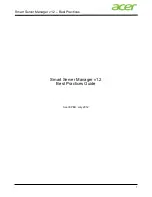
10
Chapter 2 Writing Your First ColdFusion Application
The Development Process
Whether you are creating a static HTML page or a ColdFusion application page, you
follow the same iterative process:
1
Write some code.
2
Save the code to a document or page.
3
View the page in a browser.
4
Modify the page.
5
Save the page again.
6
View it in a browser.
Working with ColdFusion Application Pages
While you can code your application pages using NotePad or any HTML editor, this
book uses ColdFusion Studio because it provides many features that make
ColdFusion development easier. You should install ColdFusion Studio if you have
not done so already.
About applicaton pages
From a coding perspective, the major difference between a static HTML page and a
ColdFusion application page is that ColdFusion pages contain ColdFusion Markup
Language (CFML). CFML is a markup language that is very similar in syntax to
HTML, so Web developers find it intuitive. Unlike HTML, which defines how things
are displayed and formatted on the client, CFML identifies specific operations that
are performed by ColdFusion Server.
Creating application pages
The following procedure creates a simple ColdFusion Application page, which you
use for other examples in this chapter.
To create a ColdFusion application page:
1
Open ColdFusion Studio.
2
Select
File > New
and select the Default Template for your new page.
3
Edit the file so that it appears as follows:
<html>
<head>
<title>Call Department</title>
</head>
<body>
<strong>Call Department</strong><br>
Summary of Contents for COLDFUSION 5-DEVELOPING
Page 1: ...Macromedia Incorporated Developing ColdFusion Applications MacroMedia ColdFusion 5 ...
Page 58: ...38 Chapter 3 Querying a Database ...
Page 134: ...114 Chapter 7 Updating Your Database ...
Page 210: ...190 Chapter 10 Reusing Code ...
Page 232: ...212 Chapter 11 Preventing and Handling Errors ...
Page 238: ...218 Chapter 12 Using the Application Framework ...
Page 262: ...242 Chapter 12 Using the Application Framework ...
Page 278: ...258 Chapter 13 Extending ColdFusion Pages with CFML Scripting ...
Page 320: ...300 Chapter 15 Indexing and Searching Data ...
Page 336: ...316 Chapter 16 Sending and Receiving E mail ...
Page 374: ...354 Chapter 18 Interacting with Remote Servers ...
















































